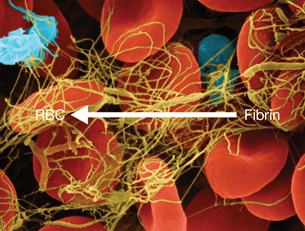Module 8 Intro
1. Module 8 Intro
1.19. Page 4
Module 8—Circulation, Immunity, and Excretion
Clotting: Platelets
shock: a serious, life-threatening condition where insufficient blood flow reaches the body tissues
As the blood carries nutrients and oxygen around the body, reduced flow hinders the delivery of these components to the tissues, and can stop the tissues from functioning properly.
coagulation: the process where a damaged blood vessel wall is covered by a platelet and fibrin- containing clot to stop bleeding and begin repair of the damaged vessel
fibrin: a mesh-like protein involved in the clotting of blood
Platelets are cell fragments of larger cells called megakaryocytes. You normally have about 150 000 to 400 000 platelets/µl of blood. The number of platelets in your bloodstream is controlled by a negative feedback system. If there are too many platelets, their production is inhibited. If there are not enough platelets in the blood, their production will be stimulated. If this value should drop much below 50,000/µl, there is a danger of uncontrolled bleeding because of the essential role that platelets have in blood clotting.
When blood vessels are cut or damaged, the loss of blood from the system must be stopped before shock and possible death occur. This is accomplished by solidification of the blood, a process called clotting or coagulation. The process of coagulation has many steps. You may read about these steps on pages 283 and 284 of the textbook.
A blood clot consists of a plug of platelets enmeshed in a network of insoluble fibrin molecules. The blood clot stimulates the growth of the structural framework and smooth muscle cells within the vessel wall. The repair process begins, and the blood clot is dissolved.

Copyright Dennis Kunkel Microscopy, Inc.
Hemophilia is a disease where the body does not have the ability to stimulate the production of a mesh–like network of fibrin molecules. As a result, an injured blood vessel in a hemophiliac will continue to lose blood for a longer period of time, and no blood clot will form. Healing also takes a longer time, which often increases the likelihood of infection or a reopening of the wound. Hemophiliacs can receive injections of a chemical that will stimulate the production of fibrin.